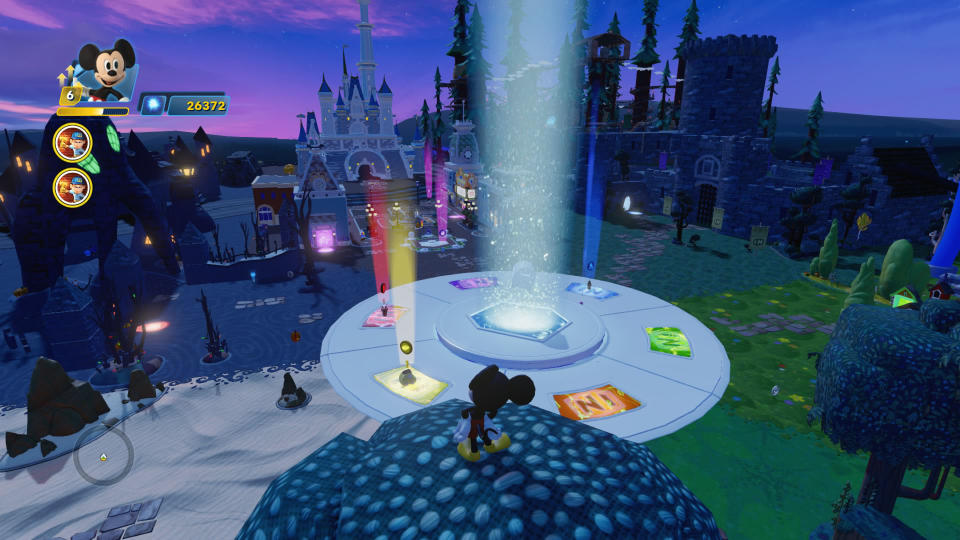'Disney Infinity' finally feels like a complete game

Nothing relies on the power of Disney's brand quite like Disney Infinity. It's the licensed game to end all licensed games, a toys-to-life platformer with all the star power of Spider-Man, Frozen, Tron, Star Wars and a dozen other Disney franchises. It's the game's selling point, but also its greatest weakness: The last two versions of the game relied on its brand-power to make up for how mediocre they were as actual video games. That's not the case anymore. With Disney Infinity 3.0, the company finally got it right. That's not to say that the first games in the series were bad, but compared to Disney Infinity 3.0, they felt a little incomplete. All the same elements are here -- the disparate Playsets that offer franchise-exclusive story-based adventures, the open-world sandbox mode that lets you create your own adventures and the adorable, collectible figures -- but they all seem to have evolved in ways that add up to a more cohesive whole.
Engaging gameplay in a galaxy far, far away

From game one, Disney Infinity's biggest problem was the relative lack of depth in its Playsets -- the franchise-specific game pieces that typically provide four to six hours of play as a story-driven experience. The problem was that they simply weren't very good, suffering from dull combat, repetitive missions and stories that failed to engage grown-ups like myself. Disney Infinity 3.0 and the Star Wars: Twilight of the Republic Playset change that. This actually feels like a substantial game.
There are a lot of things that make this new Playset stand out as a more complete experience than its predecessors, but let's focus on just three: combat gameplay, level design and linear storytelling.

Disney Interactive knew the first game was lacking in the action combat department, and brought in Ninja Theory (the studio behind action games like Heavenly Sword and DmC: Devil May Cry) to tune things up for version 2.0. The result was a much more robust combat engine with combo moves and a skill-based level system. In short, it was a massive improvement. Disney Infinity 3.0 is even better, with even more complex combos and skill sets, awesome slow-motion finishing moves and a level of polish that makes the game feel like a legitimate action platformer.
As great as the combat upgrades are, they weren't enough to save the last version, which had its improved gameplay mechanics gutted by empty, soulless level design. Disney Infinity 3.0 doesn't have this problem at all: The Star Wars: Twilight of the Republic Playset features four different locations from the prequel trilogy, and each one feels large and well-populated. Unlike on previous versions, the illusion never falters here; it doesn't feel like something I could simply throw together in the game's Toybox mode. Along with the buffer of Star Fox-like space missions above each planet, these worlds create a connected universe that seems far more massive in scale than it really is.

This authentic world-building dovetails nicely with the improved combat and, of course, the storyline. Truth be told, the Twilight of the Republic's narrative isn't particularly memorable, but it does provide more direction than previous games, nudging players through the action with clearly defined objectives and story-driven motivation. Together, these improvements create a solid action-platforming experience that, while short, can almost stand on its own apart from the rest of the game.
A theme park of creativity

As far as Disney Infinity 3.0's Playsets go, I'm more impressed by what Disney has done with the game's Toybox mode. For many players, this was the game's entire selling point: a creative sandbox area where you can create your own games and worlds to play in. It always seemed like a good idea, but it never clicked for me. The tutorials felt disorganized and pandering. I didn't know where to start and eventually gave up. Thankfully, learning to build worlds in Disney Infinity 3.0 is refreshingly easy.

If you've ever been to Disneyland, the new Toybox hub will look familiar. It features a central area that radiates out into disparate creativity "zones," modeled after the various famous theme parks. There's a driving zone, where a character from the Cars films teaches you how to handle vehicles; a combat zone where you learn to make the most of Ninja Theory's latest improvements; and four other areas with deeper tutorials on the Toybox's various mechanics.
Each area presents players with increasingly complex challenges that ease them into the different elements of the game, including how to program the more complex toys and tools with logic connections. By the time I finished the missions in the creative zone's Main Street USA (See? Disneyland!) I felt fully prepared to create my own Toybox games and worlds. I've owned every iteration of this game, and this is the first time I've been able to say that.
It's still expensive, though

I can say without hesitation or irony that Disney Infinity 3.0 is the best version of the franchise yet. In short, Disney fixed its game, taking all of its great, yet sometimes poorly executed ideas and taking the time to get them right. Even its toys are better, featuring more detailed paint jobs and special edition Star Wars figures with lightsabers that actually light up -- but all of this freshness comes at a price. At $65 for the starter pack, $35 for every expansion and $14 a figure, Disney Infinity 3.0 hits the wallet hard.
At least this time, I feel like I'm getting my money's worth.

